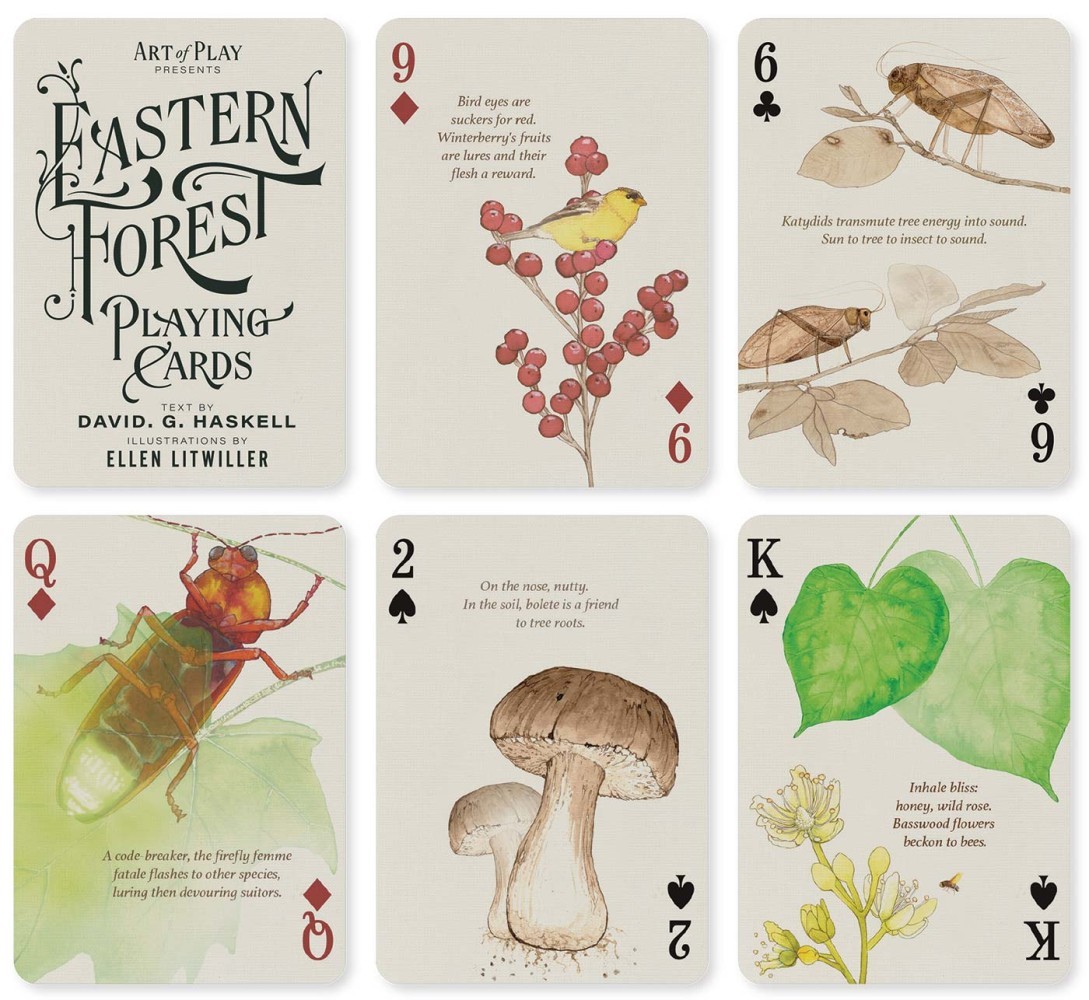
Imagine a deck of playing cards that allows you to play a game of gin rummy and also offers an invitation to explore our northern forests and to understand them in a deeper way. David George Haskell, author of the award-winning books The Songs of Trees: Stories from Nature’s Great Connectors and The Forest Unseen: A Year’s Watch in Nature, brings his rich knowledge and insights about forest relationships into a new collaboration with Art of Play, a company based in California. Artist Ellen Litwiller, who has often worked with scientists, illustrated the cards. Together they have created a deck of cards that may be used both to play traditional card games and to investigate the natural world.
“We want the cards to be an invitation to people to go out and explore, and open their senses to the forest,” said Haskell, a professor of biology and environmental studies at Sewanee, the University of the South. “As you flip through them it’ll be like walking through the woods.”
Haskell’s words and Litwiller’s intricate and colorful illustrations combine to create a deck that is at once grounded in science, lighthearted, and approachable. As Litwiller described the collaborative process, she explained that she first considered making the cards look more like entries in a guidebook, with scientific names, but in the end Haskell’s playful words called for something else. “Each project tends to have its own personality,” she explained. “I ask, ‘What’s the best visual language for that project?’” The result here is whimsical ink drawings that have a translucent quality and a lot of light and movement.
Haskell intends the cards to offer “a window into what the philosopher David Abrams calls the ‘more-than-human world.’” He noted that play is important for mental health and for forging bonds between people. It also is a critical aspect of learning. “The act of playing is a fundamental quality of intelligent vertebrate animal life. Ravens play, and wolf pups play,” he said. “It’s a way of exploring the world and taking delight in challenges. Having fun is in fact serious, important business.”
The cards capture the intricate ecological connections of northeastern forests, with each card focused on a specific element – from trees to toads, ticks to lichens, and more. There are several organizing principles to the deck.
The suits are the standard hearts, diamonds, clubs, and spades. Each suit is further organized around the senses, to help players break out of the human habit of seeing the world mainly through a visual lens. The organisms that are hearts can be particularly appreciated by touching or feeling through the skin; diamonds by looking; clubs by listening; and spades by tasting and smelling. Spades, for example, include among other things, balsam fir and actinomycetes, the microorganisms responsible for that “good earth” smell of freshly turned soil.
The deck is additionally arranged so that kings are trees, queens are invertebrates, jacks are vertebrates, and most of the aces are flowering herbaceous plants. “I wanted trees and invertebrates to be the top royalty,” said Haskell. For number cards, owl pellets, leaf litter, and leaf miner patterns are featured, along with katydids and other animals. The jokers are, of course, disruptive species: the invasive tree of heaven and European earthworms.
Each card has a very short snippet of text conveying an interesting story about its species and some connection it has to other organisms in the forest. Distilling the complexity of each card subject into fewer than a hundred characters was challenging, Haskell explained, but enjoyable. “The hope is that delight will sparkle up from the cards as people are playing,” he said.
What do you say about the American eel (jack of spades, taste and smell) if you only have a hundred characters? “A taste of the Sargasso Sea, swum inland. American eels sustained people and bears for millennia.” Eastern hemlock (king of hearts, touch and feel): “Aquatic animals delight in the cool shade cast over creeks by hemlock boughs.” Bee fly (queen of clubs, listening): “Feather duster in flight. Vrrr! Bee flies are nectar-hungry pollinators.”
Haskell expects the cards to be available through the Art of Play in September at artofplay.com.
He hopes that people’s familiarity with the cards will help them experience forests in a new way, appreciating how various aspects are connected and interdependent. “The kind of imagination I want people to have is for the everyday to become more ecologically rich,” he said.


